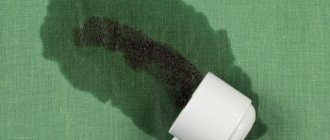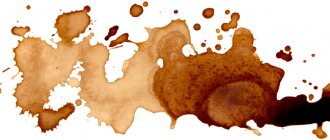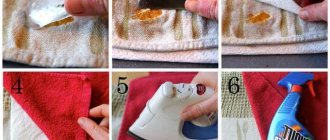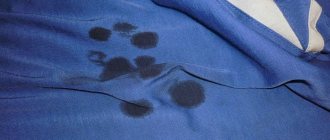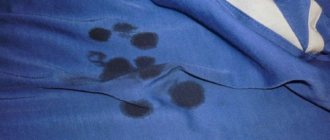Items with plasticine prints do not need to be washed immediately. First you need to completely remove the sticky, coloring substance and stains from it. Animal fat, paraffin and dye leave marks on the fabric. We must fight them.
Try this first
First you need to remove fragments of plasticine stuck to clothes. To do this, the affected item is placed in the refrigerator, or rather, in the freezer. The frozen mass can be easily removed from the fabric with the blunt side of a knife or a spatula.
To perform mechanical cleaning, sometimes it is enough to leave the item outside. When exposed to wind, the moisture will evaporate and the oils will lose their potency. The main condition is that it should not be hot, otherwise the stain will leak. Dried plasticine easily crumbles and separates from the fabric.
After this you can start making a bold print. The procedure is performed using an iron and napkins. The stain on the clothing is covered on both sides with paper napkins and ironed with a hot iron heated in the “silk” mode, as shown in the video. As a result, the oily trace should completely transfer from the fabric to the paper, which will have to be changed several times.
Advice! When separating the plasticine, do not touch it with your fingers. From the warmth of your hands, it will begin to melt, penetrate deeper into the fibers of the fabric, and even smear.
Vegetable oil
After removing the plasticine, paraffin remains in its place in the form of greasy stains. Vegetable oil can easily cope with such shine. To do this you need:
- Soak a napkin with oil and use it to rub the contaminated area;
- In place of the disappeared stain, you need to pour dishwashing detergent;
- Wait until the fat breaks down;
- Place the item in the washing machine and wash it at the maximum temperature allowed for the fabric.
Removing remaining stains
After the operations, there is still a colored mark on the clothes that needs to be washed off.
Laundry soap, which is dissolved in hot water, is suitable as a detergent. The soap solution is applied to the stain and left for 15 minutes. Then you need to lightly rub the stain, sprinkle baking soda on it and leave for another 15 minutes. All that remains is to wash the item in hot water.
You can immediately try to wash plasticine from clothes using anti-pyatin, after first soaking the stained area in it for half an hour. After this, rub the stain with a clothes brush and carry out a general wash with detergent.
Important! The final step after any method of removing plasticine is a full machine wash cycle. Additionally, it is recommended to add oxygen bleach for light-colored items or a stain remover suitable for this type of fabric.
Soda and soap
Laundry soap does most of the work, and soda perfectly complements it, increasing efficiency. The proposed method helps to clean plasticine from any type of fabric. You need to do the following:
- fill a suitable container with warm water, dissolving in it 100 g of laundry soap, previously grated;
- soak the dirty item in the solution for an hour;
- lightly clean the area of contamination with a brush, while simultaneously removing plasticine lumps from the pile;
- combine baking soda (2 tbsp) with water (1 tbsp) to make a thick paste;
- Rub the resulting mixture into the stain for 2-3 minutes, rinse with water.
8 effective methods using available tools
If for some reason it is not possible to freeze the item in the freezer to remove the plasticine, then the following easy and effective methods are suitable.
Hydrogen peroxide
- A stain left by plasticine on a light shirt can be easily removed with hydrogen peroxide. For colored clothes, it is recommended to use a stain remover, for example, Vanish. Before starting treatment, place a cloth under the stain.
Ammonia
- Traces from colored and white fabrics are removed with ammonia from a home medicine cabinet. It is enough to prepare a solution by adding 10 drops of alcohol to a glass of water, moisten a cotton swab and treat the stain. Repeat the procedure until the stain completely disappears, and change tampons periodically. At the end, rinse the item to remove the smell. The ammonia in the previous tip successfully replaces isopropyl alcohol, which can clean even denim pants without light streaks on the surface.
Peroxide with ammonia
- A combined solution with the addition of ammonia and hydrogen peroxide, which you will need 5 drops per half a glass of water, will help deal with a stain on a light blouse. Wipe the stain with the resulting mixture until it disappears. Wash the item in the usual way.
Soda
- Rub baking soda into the stained area using a toothbrush. Leave for 15-20 minutes and rinse with running water.
Vegetable oil
- Vegetable oil can remove plasticine prints on trousers, jackets and school uniforms. The affected area on the clothing should be moistened until the fabric is completely saturated. Then wash off the greasy stain using dishwashing liquid.
Kerosene
- Purified kerosene dissolves fat well, which forms the basis of plasticine. It is enough to soak a piece of cotton wool or cotton fabric in the substance and thoroughly wipe the stain. Leave for 20 minutes and wash clothes with regular detergent.
Wet wipes
- Among the unconventional ways to get rid of plastic mass on things, it is recommended to use wet wipes. Children's ones cope best with the task, for example, from.
WD-40
- WD-40 will help remove traces of plasticine from synthetic fabric products. After processing and short-term exposure for 3-5 minutes, the plasticine can be removed without much difficulty.
Kerosene
Today, the substance is sold in purified form, so you don’t have to worry about the need to remove strong odors from clothes. Kerosene should be used with extreme caution as it can corrode the paint and structure of delicate fabrics. An effective way to clean plasticine stains:
- place the soiled product on a table or any other hard surface;
- wet a cotton swab with kerosene, wring it out, apply to the stain for 8-10 minutes (5 minutes is enough for delicate fabric);
- clean the remaining substance with dry wipes by repeated application;
- Wipe the cleaned area with a slice of lemon and wash the clothes as usual.
Plasticine stains on the carpet
If a stain appears on the carpet, do not try to scrub it off with a brush. This will spread the contamination even further, and the contamination area will increase. You need to act on the same principle as with clothes, using the properties of plasticine, which melts at high temperatures and becomes brittle when frozen.
To remove the bulk of the plasticine, you need to take ice cubes from the refrigerator and place them in a bag, then apply them to the stain and hold for 15-20 minutes. In winter, take the carpet itself outside. As soon as the substance stops sticking, it is carefully separated from the pile with a dull knife or an old plastic card. It is better to collect small particles with a vacuum cleaner and immediately throw them out of the dust container before the plasticine melts and clogs the filter.
According to the second recommendation, after removing large elements, heat is applied. Cover the stain with napkins or a paper towel and iron it with a warm iron. You can use heated air from a hair dryer. The plasticine will begin to melt and soak into the paper. When it becomes dirty, it is replaced with a clean one. Finally, all that remains is to wipe the carpet with a damp cloth. This method is also suitable for upholstering a sofa.
Important! On carpets with synthetic fibers, heat must be used with caution so that the pile itself does not melt.
A trace of dye on the carpet is removed with a napkin with a warm, soapy solution of laundry soap or dishwashing detergent. Carpet detergent is also suitable. The remaining prints are cleaned with a paste of soda and water. Dry powder is removed with a brush.
Special carpet cleaning products
There are detergents that can dissolve plasticine. They should be used.
- Any solvent will do, such as acetone, white spirit or gasoline. Moisten a sponge with any of the products and treat the contaminated area, moving from the outer contour to the middle. Repeat several times and wipe the carpet with a slightly damp cloth.
- Apply car interior cleaner to the affected area and leave for 2 hours. During this time, the plasticine will dissolve and can be removed with a cloth moistened with water.
- A cleaning cream designed for other surfaces is also effective. It is spread over a dry carpet and rubbed with a damp sponge. After treatment, remove the foam several times with a clean sponge.
Isopropyl alcohol
This method of cleaning plasticine is only suitable for cotton items. You cannot use alcohol on other materials, as this will ruin them. To clean a sticky stain:
- place damaged clothing on a hard surface;
- moisten the area of contamination with a few drops of alcohol;
- after a minute, wash off the remaining alcohol from the item;
- wash the product immediately after this.
Isopropyl alcohol is a flammable substance; any interaction with it must be carried out in compliance with safety rules. It is necessary to work with liquid and store it away from open flames and sources of high temperatures. Alcohol quickly evaporates when mixed with air, and at high concentrations forms an explosive composition, so work with the substance should be carried out in well-ventilated areas. In addition, wear gloves - with prolonged contact with skin, alcohol can cause chemical burns.
What to do if plasticine is “smart”
“Smart” plasticine or “chewing gum for hands” is intended for adults to relieve stress and stabilize the emotional background. It is made on the basis of silicone, not wax, but it also leaves imprints. Dealing with them is not easy and traditional methods are not suitable here.
You can get rid of stains yourself only on fabrics made from natural fibers - cotton, linen, silk, wool. To do this, you need to find cleaning alcohol (70% isopropyl alcohol). Pour it directly onto the stain and watch how it quickly dissolves the sticky mass right before your eyes. Finally, blot the moisture with a napkin and wash the clothes.
Synthetic products with traces of chewing gum will have to be taken to the dry cleaner. Home remedies are powerless here.
What is the difficulty
The difficulty in removing plasticine is as follows:
- The substance is sensitive to temperature fluctuations, and the warmth of human hands is enough to make it more plastic. This makes it much more difficult to remove.
- The substance contains various dyes. Because of this, the item not only gets dirty, but also takes on the color scheme of the dirt.
- Plasticine contains fats, which forces you to think not only about its removal, but also about removing oil stains remaining at the contact site.
This is interesting: How to wash velor items: methods of proper washing and ironing
Bulk removal
First, remove large pieces of plasticine with any hard object. For example, it is convenient to use a small knife. To disrupt the optimal stickiness state, the residues can be heated or cooled.
Freezing
To harden, you need to lower the temperature as much as possible. At the same time, the substance becomes harder and sticky properties are minimized. The following methods can be used at home:
- Place the stained clothing in a plastic bag, stain side up, and place in the freezer for 2-3 hours.
- Use ice, less effective, but a great alternative to avoid freezing the item completely. To keep the cloth dry, place the ice on a thin metal bowl or mug.
- Use special cooling aerosols.
After the selected manipulation, the plasticine will become harder. Break it into small pieces and use a stiff brush or small knife to get rid of the residue.
After cooling, the plasticine should not come into contact with hot objects, including hands. Try not to damage the fabric; it may even break if frozen.
Heating
Heating will help remove plasticine from clothes. At the same time, the sticky properties increase, which we will use for our own purposes. Don't worry, you don't need an open fire, you just need an iron and paper towels or napkins. You need to make sure that the plasticine transfers from clothes to towels. As the stickiness increases, it will stick to everything, you just need to substitute the right object.
- Place a paper towel under and on your clothing. If you need to clean your pants, place the stain inside the pant leg.
- Now start ironing at low temperatures.
- When the plasticine remains on the towels, replace them with new ones.
- Continue until complete removal.
By the way, it is better to use napkins, since they are thicker. When using paper towels, fold them in several layers.
